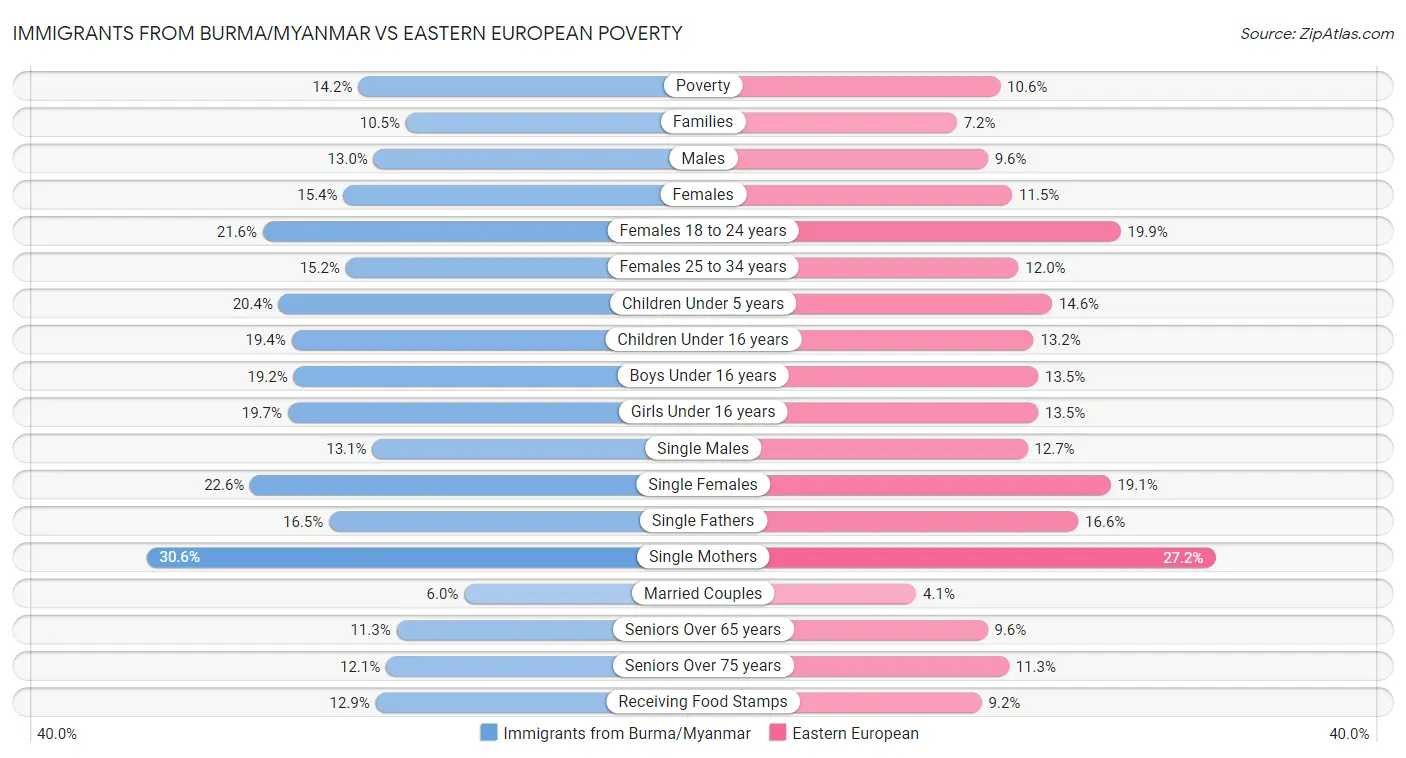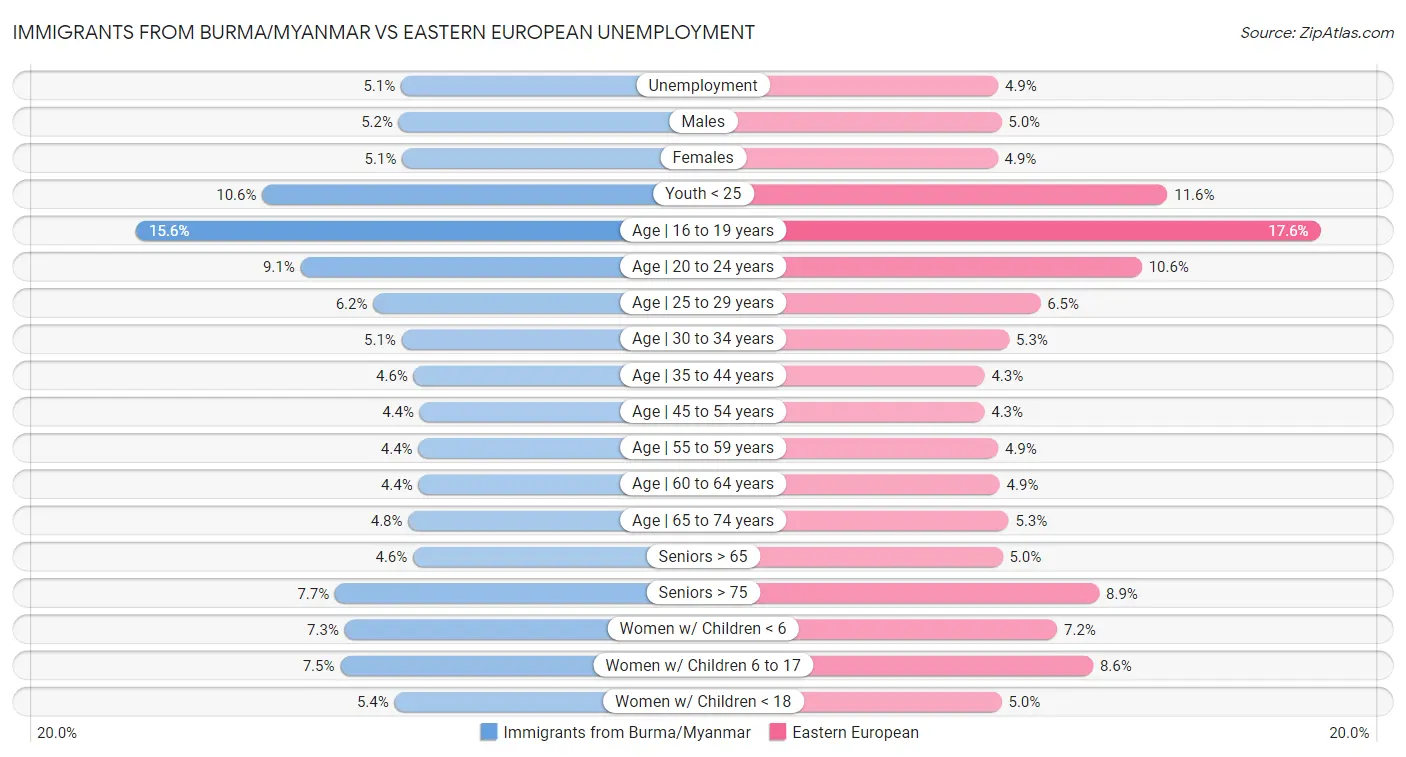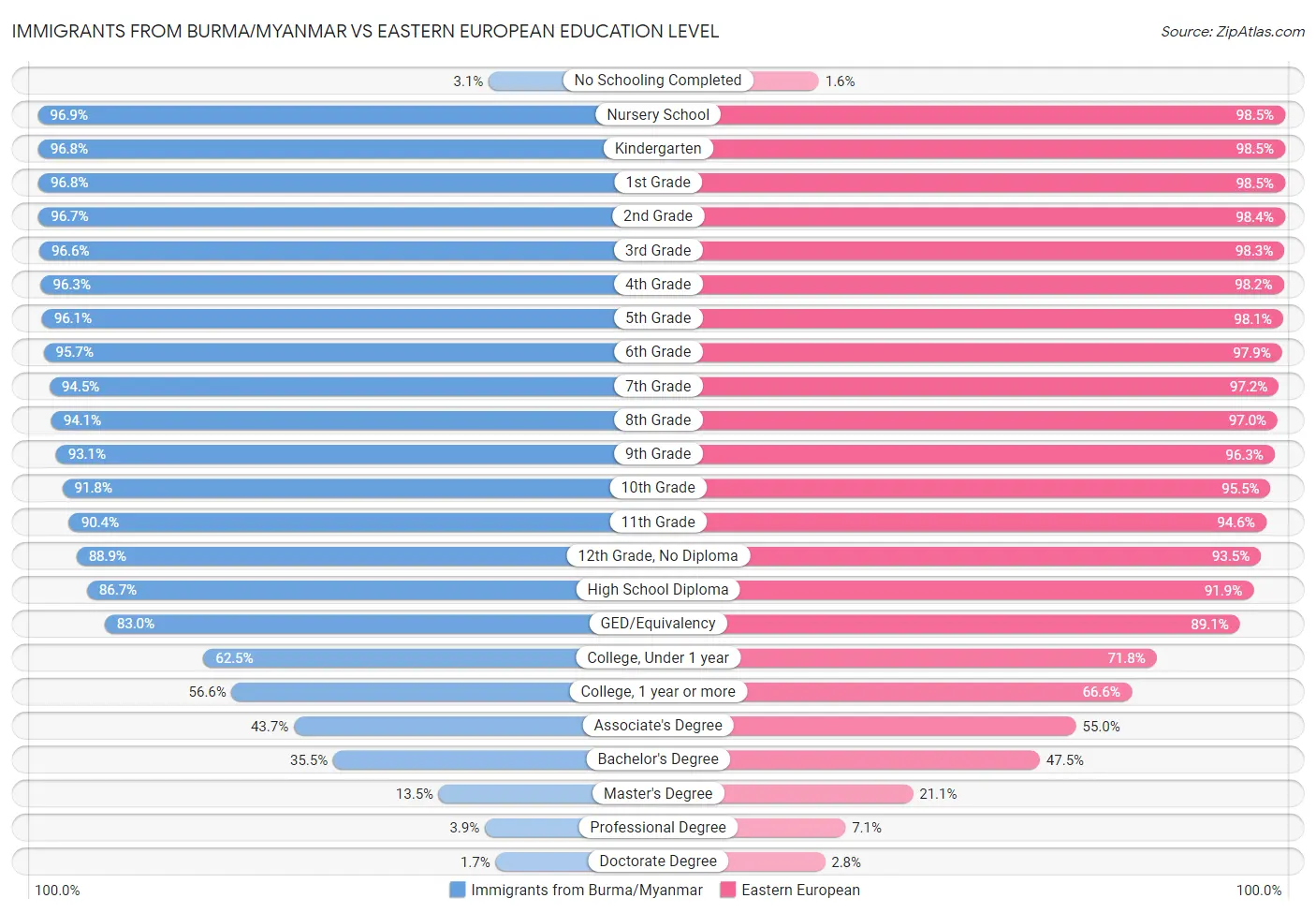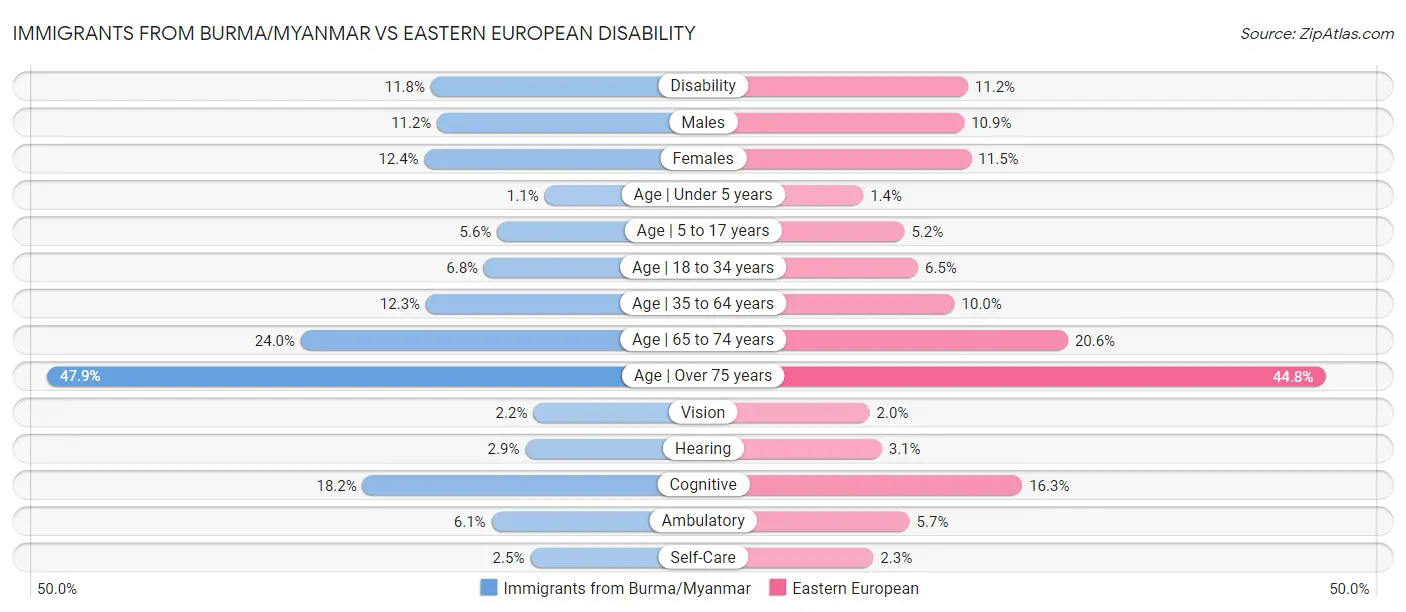Immigrants from Burma/Myanmar vs Eastern European Community Comparison
COMPARE
Immigrants from Burma/Myanmar
Eastern European
Social Comparison
Social Comparison
Immigrants from Burma/Myanmar
Eastern Europeans
3,365
SOCIAL INDEX
31.2/ 100
SOCIAL RATING
222nd/ 347
SOCIAL RANK
8,758
SOCIAL INDEX
85.0/ 100
SOCIAL RATING
52nd/ 347
SOCIAL RANK
Eastern European Integration in Immigrants from Burma/Myanmar Communities
The statistical analysis conducted on geographies consisting of 162,693,725 people shows no correlation between the proportion of Eastern Europeans within Immigrant from Burma/Myanmar communities in the United States with a correlation coefficient (R) of -0.044. On average, for every 1% (one percent) increase in Immigrants from Burma/Myanmar within a typical geography, there is a decrease of 0.007% in Eastern Europeans. To illustrate, in a geography comprising of 100,000 individuals, a rise of 1,000 Immigrants from Burma/Myanmar corresponds to a decrease of 7.2 Eastern Europeans.

Immigrants from Burma/Myanmar vs Eastern European Income
When considering income, the most significant differences between Immigrants from Burma/Myanmar and Eastern European communities in the United States are seen in per capita income ($39,827 compared to $55,780, a difference of 40.1%), median family income ($94,472 compared to $125,546, a difference of 32.9%), and median male earnings ($50,298 compared to $66,472, a difference of 32.2%). Conversely, both communities are more comparable in terms of householder income under 25 years ($48,749 compared to $54,066, a difference of 10.9%), median female earnings ($38,028 compared to $45,385, a difference of 19.4%), and householder income over 65 years ($57,114 compared to $70,470, a difference of 23.4%).

| Income Metric | Immigrants from Burma/Myanmar | Eastern European |
| Per Capita Income | Tragic $39,827 | Exceptional $55,780 |
| Median Family Income | Tragic $94,472 | Exceptional $125,546 |
| Median Household Income | Tragic $78,682 | Exceptional $101,781 |
| Median Earnings | Tragic $43,998 | Exceptional $55,084 |
| Median Male Earnings | Tragic $50,298 | Exceptional $66,472 |
| Median Female Earnings | Tragic $38,028 | Exceptional $45,385 |
| Householder Age | Under 25 years | Tragic $48,749 | Exceptional $54,066 |
| Householder Age | 25 - 44 years | Tragic $86,736 | Exceptional $114,523 |
| Householder Age | 45 - 64 years | Tragic $91,385 | Exceptional $120,684 |
| Householder Age | Over 65 years | Tragic $57,114 | Exceptional $70,470 |
| Wage/Income Gap | Exceptional 22.8% | Tragic 28.6% |
Immigrants from Burma/Myanmar vs Eastern European Poverty
When considering poverty, the most significant differences between Immigrants from Burma/Myanmar and Eastern European communities in the United States are seen in child poverty under the age of 16 (19.4% compared to 13.2%, a difference of 46.9%), married-couple family poverty (6.0% compared to 4.1%, a difference of 46.7%), and family poverty (10.5% compared to 7.2%, a difference of 45.4%). Conversely, both communities are more comparable in terms of single father poverty (16.5% compared to 16.6%, a difference of 0.98%), single male poverty (13.1% compared to 12.7%, a difference of 3.3%), and seniors poverty over the age of 75 (12.1% compared to 11.3%, a difference of 7.1%).

| Poverty Metric | Immigrants from Burma/Myanmar | Eastern European |
| Poverty | Tragic 14.2% | Exceptional 10.6% |
| Families | Tragic 10.5% | Exceptional 7.2% |
| Males | Tragic 13.0% | Exceptional 9.6% |
| Females | Tragic 15.4% | Exceptional 11.5% |
| Females 18 to 24 years | Tragic 21.6% | Good 19.9% |
| Females 25 to 34 years | Tragic 15.2% | Exceptional 12.0% |
| Children Under 5 years | Tragic 20.4% | Exceptional 14.6% |
| Children Under 16 years | Tragic 19.4% | Exceptional 13.2% |
| Boys Under 16 years | Tragic 19.2% | Exceptional 13.5% |
| Girls Under 16 years | Tragic 19.7% | Exceptional 13.5% |
| Single Males | Poor 13.1% | Good 12.7% |
| Single Females | Tragic 22.6% | Exceptional 19.1% |
| Single Fathers | Fair 16.5% | Poor 16.6% |
| Single Mothers | Tragic 30.6% | Exceptional 27.2% |
| Married Couples | Tragic 6.0% | Exceptional 4.1% |
| Seniors Over 65 years | Fair 11.3% | Exceptional 9.6% |
| Seniors Over 75 years | Good 12.1% | Exceptional 11.3% |
| Receiving Food Stamps | Tragic 12.9% | Exceptional 9.2% |
Immigrants from Burma/Myanmar vs Eastern European Unemployment
When considering unemployment, the most significant differences between Immigrants from Burma/Myanmar and Eastern European communities in the United States are seen in unemployment among ages 20 to 24 years (9.1% compared to 10.6%, a difference of 16.2%), unemployment among seniors over 75 years (7.7% compared to 8.9%, a difference of 14.8%), and unemployment among women with children ages 6 to 17 years (7.5% compared to 8.6%, a difference of 14.8%). Conversely, both communities are more comparable in terms of unemployment among ages 45 to 54 years (4.4% compared to 4.3%, a difference of 0.95%), unemployment among women with children under 6 years (7.3% compared to 7.2%, a difference of 1.8%), and male unemployment (5.2% compared to 5.0%, a difference of 4.0%).

| Unemployment Metric | Immigrants from Burma/Myanmar | Eastern European |
| Unemployment | Excellent 5.1% | Exceptional 4.9% |
| Males | Good 5.2% | Exceptional 5.0% |
| Females | Exceptional 5.1% | Exceptional 4.9% |
| Youth < 25 | Exceptional 10.6% | Average 11.6% |
| Age | 16 to 19 years | Exceptional 15.6% | Average 17.6% |
| Age | 20 to 24 years | Exceptional 9.1% | Tragic 10.6% |
| Age | 25 to 29 years | Exceptional 6.2% | Good 6.5% |
| Age | 30 to 34 years | Exceptional 5.1% | Excellent 5.3% |
| Age | 35 to 44 years | Good 4.6% | Exceptional 4.3% |
| Age | 45 to 54 years | Exceptional 4.4% | Exceptional 4.3% |
| Age | 55 to 59 years | Exceptional 4.4% | Fair 4.9% |
| Age | 60 to 64 years | Exceptional 4.4% | Poor 4.9% |
| Age | 65 to 74 years | Exceptional 4.8% | Excellent 5.3% |
| Seniors > 65 | Exceptional 4.6% | Exceptional 5.0% |
| Seniors > 75 | Exceptional 7.7% | Fair 8.9% |
| Women w/ Children < 6 | Exceptional 7.3% | Exceptional 7.2% |
| Women w/ Children 6 to 17 | Exceptional 7.5% | Exceptional 8.6% |
| Women w/ Children < 18 | Good 5.4% | Exceptional 5.0% |
Immigrants from Burma/Myanmar vs Eastern European Labor Participation
When considering labor participation, the most significant differences between Immigrants from Burma/Myanmar and Eastern European communities in the United States are seen in in labor force | age 16-19 (39.0% compared to 36.4%, a difference of 7.4%), in labor force | age 20-24 (76.3% compared to 74.8%, a difference of 2.1%), and in labor force | age > 16 (66.3% compared to 65.1%, a difference of 1.9%). Conversely, both communities are more comparable in terms of in labor force | age 20-64 (79.7% compared to 80.2%, a difference of 0.71%), in labor force | age 25-29 (84.7% compared to 85.5%, a difference of 0.96%), and in labor force | age 30-34 (84.7% compared to 85.7%, a difference of 1.2%).

| Labor Participation Metric | Immigrants from Burma/Myanmar | Eastern European |
| In Labor Force | Age > 16 | Exceptional 66.3% | Average 65.1% |
| In Labor Force | Age 20-64 | Good 79.7% | Exceptional 80.2% |
| In Labor Force | Age 16-19 | Exceptional 39.0% | Fair 36.4% |
| In Labor Force | Age 20-24 | Exceptional 76.3% | Fair 74.8% |
| In Labor Force | Age 25-29 | Average 84.7% | Exceptional 85.5% |
| In Labor Force | Age 30-34 | Average 84.7% | Exceptional 85.7% |
| In Labor Force | Age 35-44 | Tragic 84.0% | Exceptional 85.2% |
| In Labor Force | Age 45-54 | Tragic 82.0% | Exceptional 83.5% |
Immigrants from Burma/Myanmar vs Eastern European Family Structure
When considering family structure, the most significant differences between Immigrants from Burma/Myanmar and Eastern European communities in the United States are seen in single mother households (7.0% compared to 5.2%, a difference of 35.8%), single father households (2.4% compared to 2.0%, a difference of 23.8%), and births to unmarried women (32.9% compared to 27.7%, a difference of 18.5%). Conversely, both communities are more comparable in terms of family households (62.6% compared to 63.4%, a difference of 1.3%), family households with children (28.0% compared to 26.7%, a difference of 5.0%), and average family size (3.29 compared to 3.12, a difference of 5.5%).

| Family Structure Metric | Immigrants from Burma/Myanmar | Eastern European |
| Family Households | Tragic 62.6% | Tragic 63.4% |
| Family Households with Children | Exceptional 28.0% | Tragic 26.7% |
| Married-couple Households | Tragic 43.4% | Exceptional 48.6% |
| Average Family Size | Exceptional 3.29 | Tragic 3.12 |
| Single Father Households | Poor 2.4% | Exceptional 2.0% |
| Single Mother Households | Tragic 7.0% | Exceptional 5.2% |
| Currently Married | Tragic 44.3% | Exceptional 48.9% |
| Divorced or Separated | Fair 12.1% | Exceptional 11.3% |
| Births to Unmarried Women | Poor 32.9% | Exceptional 27.7% |
Immigrants from Burma/Myanmar vs Eastern European Vehicle Availability
When considering vehicle availability, the most significant differences between Immigrants from Burma/Myanmar and Eastern European communities in the United States are seen in no vehicles in household (10.4% compared to 11.7%, a difference of 12.0%), 4 or more vehicles in household (6.2% compared to 5.9%, a difference of 5.7%), and 2 or more vehicles in household (53.9% compared to 54.8%, a difference of 1.6%). Conversely, both communities are more comparable in terms of 3 or more vehicles in household (18.8% compared to 18.7%, a difference of 0.56%), 1 or more vehicles in household (89.7% compared to 88.5%, a difference of 1.3%), and 2 or more vehicles in household (53.9% compared to 54.8%, a difference of 1.6%).

| Vehicle Availability Metric | Immigrants from Burma/Myanmar | Eastern European |
| No Vehicles Available | Average 10.4% | Tragic 11.7% |
| 1+ Vehicles Available | Average 89.7% | Tragic 88.5% |
| 2+ Vehicles Available | Tragic 53.9% | Fair 54.8% |
| 3+ Vehicles Available | Poor 18.8% | Poor 18.7% |
| 4+ Vehicles Available | Fair 6.2% | Tragic 5.9% |
Immigrants from Burma/Myanmar vs Eastern European Education Level
When considering education level, the most significant differences between Immigrants from Burma/Myanmar and Eastern European communities in the United States are seen in no schooling completed (3.1% compared to 1.6%, a difference of 102.0%), professional degree (3.9% compared to 7.1%, a difference of 79.7%), and doctorate degree (1.7% compared to 2.8%, a difference of 64.6%). Conversely, both communities are more comparable in terms of nursery school (96.9% compared to 98.5%, a difference of 1.7%), kindergarten (96.8% compared to 98.5%, a difference of 1.7%), and 1st grade (96.8% compared to 98.5%, a difference of 1.7%).

| Education Level Metric | Immigrants from Burma/Myanmar | Eastern European |
| No Schooling Completed | Tragic 3.1% | Exceptional 1.6% |
| Nursery School | Tragic 96.9% | Exceptional 98.5% |
| Kindergarten | Tragic 96.8% | Exceptional 98.5% |
| 1st Grade | Tragic 96.8% | Exceptional 98.5% |
| 2nd Grade | Tragic 96.7% | Exceptional 98.4% |
| 3rd Grade | Tragic 96.6% | Exceptional 98.3% |
| 4th Grade | Tragic 96.3% | Exceptional 98.2% |
| 5th Grade | Tragic 96.1% | Exceptional 98.1% |
| 6th Grade | Tragic 95.7% | Exceptional 97.9% |
| 7th Grade | Tragic 94.5% | Exceptional 97.2% |
| 8th Grade | Tragic 94.1% | Exceptional 97.0% |
| 9th Grade | Tragic 93.1% | Exceptional 96.3% |
| 10th Grade | Tragic 91.8% | Exceptional 95.5% |
| 11th Grade | Tragic 90.4% | Exceptional 94.6% |
| 12th Grade, No Diploma | Tragic 88.9% | Exceptional 93.5% |
| High School Diploma | Tragic 86.7% | Exceptional 91.9% |
| GED/Equivalency | Tragic 83.0% | Exceptional 89.1% |
| College, Under 1 year | Tragic 62.5% | Exceptional 71.8% |
| College, 1 year or more | Tragic 56.6% | Exceptional 66.6% |
| Associate's Degree | Tragic 43.7% | Exceptional 55.0% |
| Bachelor's Degree | Tragic 35.5% | Exceptional 47.5% |
| Master's Degree | Tragic 13.5% | Exceptional 21.1% |
| Professional Degree | Tragic 3.9% | Exceptional 7.1% |
| Doctorate Degree | Poor 1.7% | Exceptional 2.8% |
Immigrants from Burma/Myanmar vs Eastern European Disability
When considering disability, the most significant differences between Immigrants from Burma/Myanmar and Eastern European communities in the United States are seen in disability age 35 to 64 (12.3% compared to 10.0%, a difference of 23.2%), disability age under 5 (1.1% compared to 1.4%, a difference of 21.4%), and disability age 65 to 74 (24.0% compared to 20.6%, a difference of 16.6%). Conversely, both communities are more comparable in terms of male disability (11.2% compared to 10.9%, a difference of 3.2%), disability age 18 to 34 (6.8% compared to 6.5%, a difference of 4.5%), and disability (11.8% compared to 11.2%, a difference of 5.4%).

| Disability Metric | Immigrants from Burma/Myanmar | Eastern European |
| Disability | Fair 11.8% | Exceptional 11.2% |
| Males | Average 11.2% | Exceptional 10.9% |
| Females | Poor 12.4% | Exceptional 11.5% |
| Age | Under 5 years | Exceptional 1.1% | Tragic 1.4% |
| Age | 5 to 17 years | Average 5.6% | Exceptional 5.2% |
| Age | 18 to 34 years | Poor 6.8% | Good 6.5% |
| Age | 35 to 64 years | Tragic 12.3% | Exceptional 10.0% |
| Age | 65 to 74 years | Poor 24.0% | Exceptional 20.6% |
| Age | Over 75 years | Poor 47.9% | Exceptional 44.8% |
| Vision | Fair 2.2% | Exceptional 2.0% |
| Hearing | Good 2.9% | Poor 3.1% |
| Cognitive | Tragic 18.2% | Exceptional 16.3% |
| Ambulatory | Average 6.1% | Exceptional 5.7% |
| Self-Care | Average 2.5% | Exceptional 2.3% |